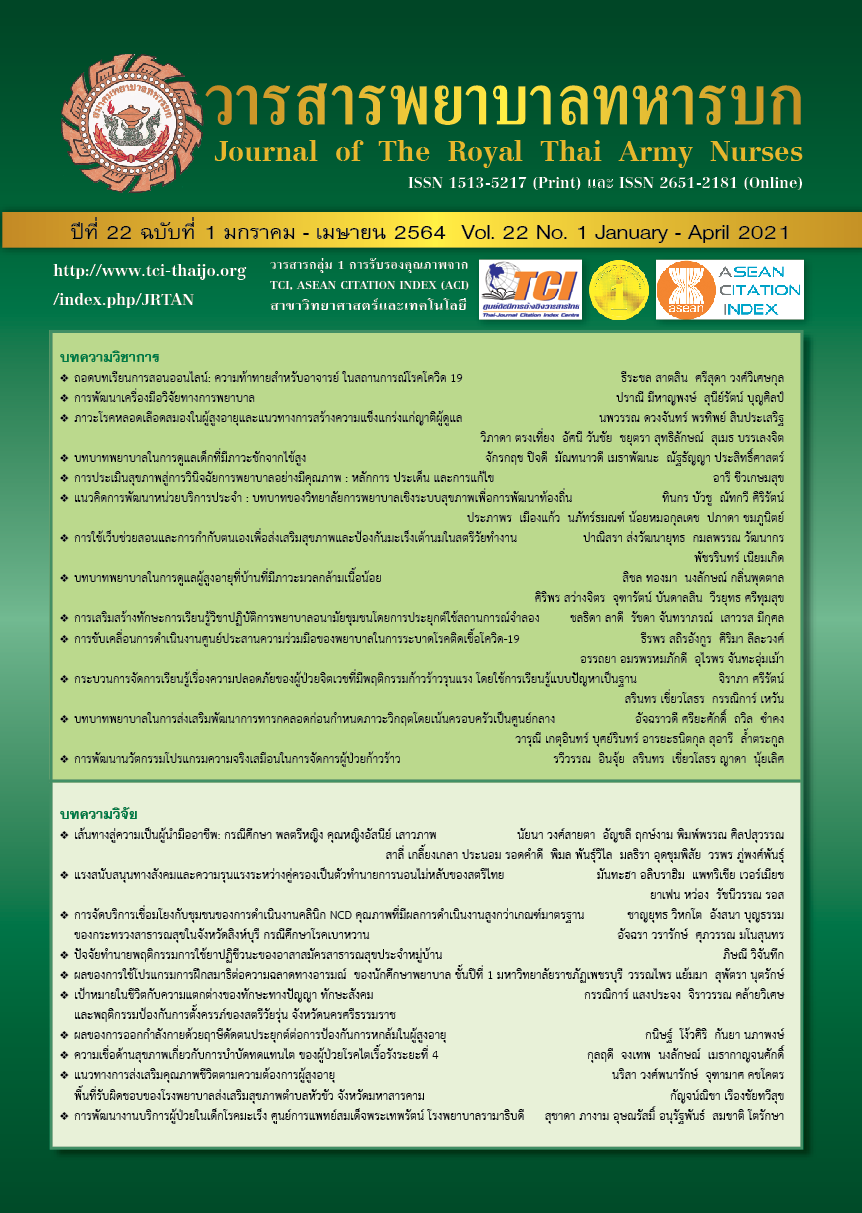The Effects of Health Belief Model Program on Knowledge, Stroke Prevention Behavior and Blood Pressure Levels in Hypertensive Patients The Responsibility Area of Kaeng Khro Hospital, Chaiyaphum Province
Keywords:
health belief model, preventing stroke, hypertensive patientsAbstract
The two groups Quasi-experimental design research was taken by pre-post measurement technique. The objectives were to study the effects of Health Belief Model Program on knowledge, stroke prevention behavior and blood pressure levels in hypertensive patients, located in the responsibility area of Kaeng Khro Hospital, Chaiyaphum province. Based on applied Health Belief Model mixed method with the concept of seven-colors Life Traffic Table Tennis and mobile phone follow-up. Samples were hypertensive patients with recruited by simple random sampling then assigned to be two groups, each group was 30 person. Proceeding from April to September of 2020. Collecting data by pre-post intervention questionnaire. Analyzing data by percentage, mean, standard deviation and t-test.
Results found that post-intervention, the experimental group that received Health Belief Model Program had average knowledge, stroke prevention score higher than pre-intervention including average blood pressure level lesser than pre-intervention significantly (p-value <.05) Moreover, post-intervention, the experimental group that received Health Belief Model Program had average knowledge, stroke prevention score higher than pre-intervention including average blood pressure level lesser than pre-intervention significantly (p-value <.05) particular compared with the control group. Thus, conclusion support that Health Belief Model influencing the experimental group on knowledge, causation belief, symptoms of disease, self perception of exposure risk and more serious complication. Involved higher competency of stroke prevention behavior and enable reduced blood pressure level also.
Downloads
References
Arkhom Arayawichanon. Critical Care Neurology. Ubon Ratchathani : Siritham Offset Printing House. 2005; 144. (in Thai)
World Stroke Organization: (WSO). Annual Report. 2019.
Bureau of Policy and Strategy, Ministry of Public Health Public Health Statistics A.D. 2019. (in Thai)
Jaipong S, Srithumsuk W, Charoensan P, Chamnongchit S, Munsil J & Pansri S. A Study of Severity and Perception of Disease’s Severity to Hospital Arrival Time for relatives of Acute Stroke Patient. Journal of The Royal Thai Army Nurse. 2020; 21(2): 273-285. (in Thai)
Charmnanpoh R, Sangchan H. & Chinnawong T. Relationship Between Symptom Experiences, Symptom Management and Stroke Severity of Patients with Acute Ischemic Stroke. Songklanagarind Journal of Nursing. 2020; 40(1): 140-153. (in Thai)
Nilnate N. Risk Factors and Prevention of Stroke in Hypertensive Patients. Journal of The Royal Thai Army Nurses. 2019; 20(2): 51-57. (in Thai)
Prombut P & Piaseu N, Sakulhongsopon S. Factors Related to Stress of Family Caregiver of Patients with Stroke at Home Rama Nursing Journal. 2014; 20(1): 82-96.
Chantra R, Sansuwan R & Heeaksorn C. Care for Stroke Patients with a Multidisciplinary Team. Journal of The Royal Thai Army Nurses. 2017; 18:(Suppl) 49-55. (in Thai)
Khantamoon R & Daenseekaew S. SelfManagementamongpeople with uncontrolled hypertension. Journal of Nursing and Health Care. 2017; 35(2): 89-97. (in Thai)
Klinsakorn C. & Saetan S. Factors Related to Self-Protective Behavior of Stroke with Controlled Hypertention Patients Who Live in Danchang District, Suphanburi Province. Journal of Council of Community Public Health. 2020; 2(2): 62-77. (in Thai)
LEE HR, HAM OK, LEE YW, CHO I, OH HS & RHA JH. Knowledge, health-promoting behaviors, and biological risks of recurrent stroke among stroke patients in Korea. Japan Journal of Nursing Science. 2014; 11(2): 112-120.
Jeon MY & Jeong HC. Effects of a Stroke Primary Prevention Program on Risk Factors for At-Home Elderly. Medical Science Monitor. 2018; 21: 3696-3703.
Juwa s, Wongwat R & Manoton A. The Effectiveness of the Health Behavior Change Program with 7 Colors Ball Tool on Knowledge, Health Belief and Behavior Related to the Prevention and Control of Hypertension and Diabetes Mellitus, in Maeka Sub-District, Muang District, Phayao Province. Songklanagarind Journal of Nursing. 2019; 39(2): 127-141. (in Thai)
Rosenstock, M.l., Strecher, V.J., & Becker, M.H. Social learningTheoryand Earth Belief Model. Health Education Quarterly, 1988; 15(2): 75-138.
Pragodpol P & Intana J. The Effect of the Stroke Warning Signs Program on Stroke’s Awareness, Knowledge, and Practice to Decrease the Stroke Risk in Hypertensive Patients. Journal of Phapokklao Nursing College. 2019; 30(2): 88-100. (in Thai)
Loussug W, Lawang W & Homsin P. The Effects of Application of the Health Belief Model with Family Support Program on Preventive Behaviors Against Cerebrovascular Disease among Individual at Risk. Journal of Nursing and Education. 2019.; 12(4): 32-45. (in Thai)
Cohen J. Statistical power analysis for the behavioral sciences. New Jerseys: lawence Earlbaum Associates; 1998.
Best, J. W. research in education 3rd ed. Englewood Cliffs, New Jersey: Prentice Hall, Inc. 1977.
Lahkum S & Intaranongpai S. Relationship between health belief perception and stroke prevention behavior in high risk patients in Nuea Mueang sub district, Mueang district, Roiet province. Journal of the Police Nurses. 2017; 9(2): 85-94. (in Thai)
Patsadu P, Jong-Udomkarn D. Development of Community Health System to Prevent Cerebrovascular Disease among Risk Group. Thai Red cross Nursing Journal. 2020; 13(1): 179-199. (in Thai)
Chayarut P, Roojanavech S, Chatdokmaiprai K. The Effects of Health Risk Communication Program among Patients with Risk of Diabetic Retinopathy in a community Samut Sakhon Province. Journal of The Royal Thai Army Nurses. 2019; 20(3): 206-217. (in Thai)
Duangjinda M, Nimit-Arnun N. & Roojanavech S. The Outcomes of Health Risk Communication Program Amongst High Risk Stroke Patients at Sub - district Health Promoting Hospitals in SamutSakhon Province. Journal of The Royal Thai Army Nurses. 2016; 17(2): 59-67. (in Thai)
Downloads
Published
How to Cite
Issue
Section
License
บทความหรือข้อคิดเห็นใดใดที่ปรากฏในวารสารพยาบาลทหารบกเป็นวรรณกรรมของผู้เขียน ซึ่งบรรณาธิการหรือสมาคมพยาบาลทหารบก ไม่จำเป็นต้องเห็นด้วย
บทความที่ได้รับการตีพิมพ์เป็นลิขสิทธิ์ของวารสารพยาบาลทหารบก
The ideas and opinions expressed in the Journal of The Royal Thai Army Nurses are those of the authors and not necessarily those
of the editor or Royal Thai Army Nurses Association.






